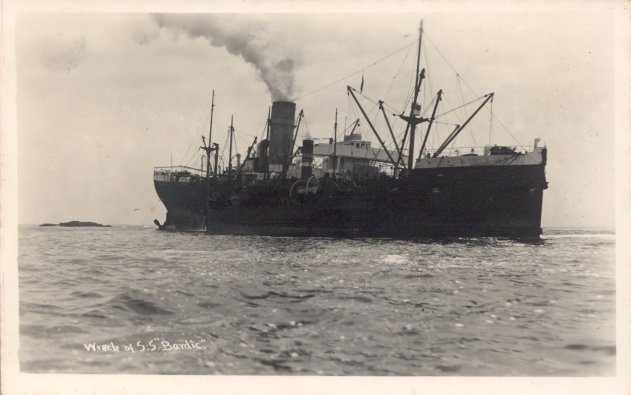To meet Britain's need for cargo capacity during the first world war,
the Shipping Controller arranged for the construction of several types
of "War Standard" ships. Bardic was originally one of these, and one of
three "G" type War Standard ships purchased by White Star after the war
ended. (Gallic (II)
and Delphic were the other two.) Built by Harland & Wolff, Belfast, she
was launched as War Priam in December 1918, but during her fitting out she
was sold to White Star and renamed Bardic.
A cargo carrier with no passenger accommodations, Bardic made her maiden
voyage from Liverpool to New York on 18 March 1919. From June 1919 until
April 1921, Bardic was under the management of the Atlantic Transport Line,
and ran on ATL's London-New York service. In May 1920, Bardic returned to
White Star, on the line's Australia service. She remained on that service
for her entire White Star career, which lasted until 1925.
For about a month of that time (31 August to 29 September 1924), she was
stranded on Stag Rock, Lizard, having gone aground just a few hundred yards
from where Suevic
had grounded in 1907. She suffered severe bottom damage, but was returned
to service later in 1924 after repairs were made, initially in drydock at
Falmouth and then at Harland & Wolff.
In 1925, Bardic was sold to the Aberdeen Line, which renamed her Hostilius
and, in 1926, Horatius. She was again transferred in 1932, this time winding
up with Shaw, Savill & Albion, and renamed Kumara. Finally, she was sold to
John Latsis of Piraeus in 1937, and renamed Marathon.
A convoy straggler proceeding at her own pace, Marathon was sunk by the
German battlecruiser Scharnhorst on 9 March 1941, northeast of the Cape Verde
Islands. However, her radio warnings permitted the rest of her convoy to
escape.
Sources: Anderson's White Star; Haws' Merchant Fleets; Eaton & Haas' Falling
Star; Moss and Hume's Shipbuilders to the World

